Does your approach need a rethink?
Effective and efficient management of power within the datacentre is essential to IT service delivery in a rapidly changing business environment. A recent survey of 320 datacentre professionals, however, illustrates that power management is an area in which many recognise they could do better. In operational terms, the shortfalls that exist potentially undermine the organisations’ ability to meet energy efficiency needs, and to avoid power-related failures and outages. On the positive side, the survey also reveals that the value of modern power management tools is broadly acknowledged, and that investments in this space can help to deliver the improvements many need to make. Indeed, those organisations currently using such tools seem to be already achieving better results. Business demands on IT are ramping up, and in a majority of organisations this is increasing the pressure on the systems infrastructure, and in turn the underlying facilities that keep datacentres functioning effectively and efficiently. It is therefore not surprising that in a recent research study, effective management of datacentre facilities, e.g. power and cooling, was generally seen to be important to achieving an acceptable level of business continuity.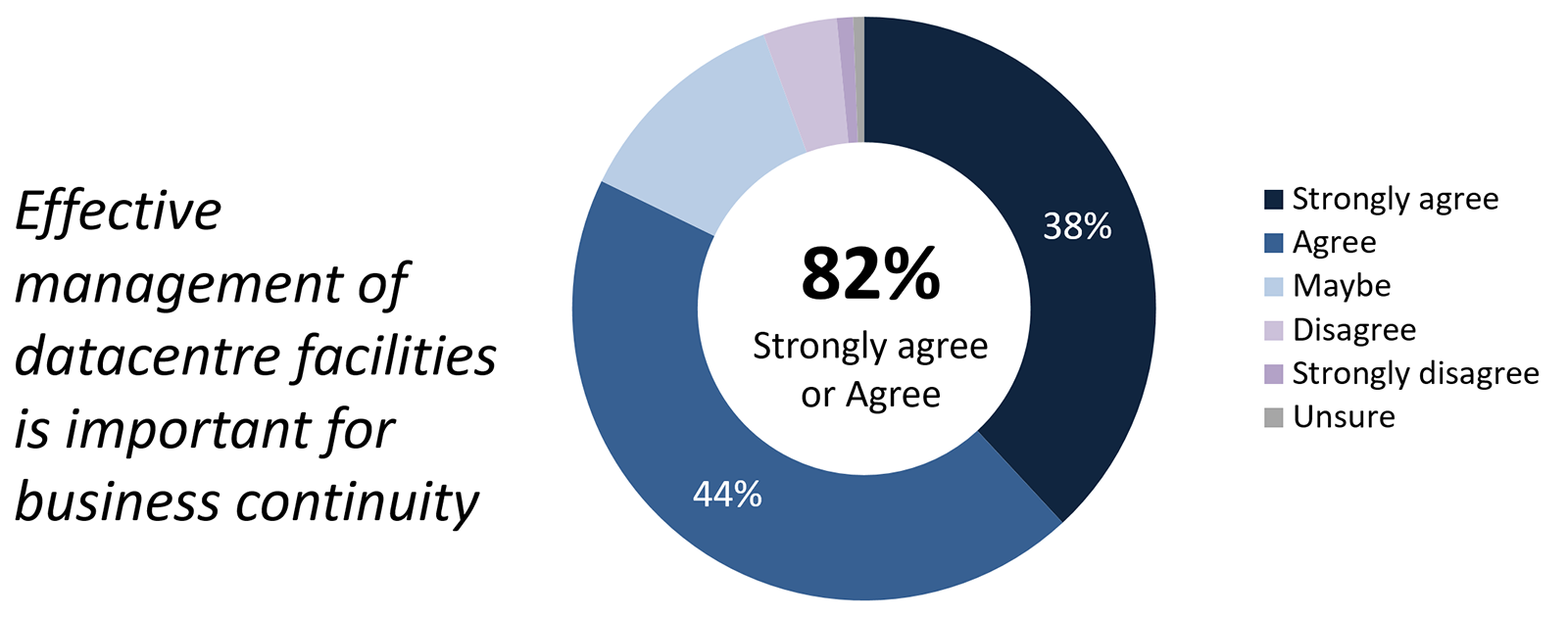 Turning to power specifically, the survey highlighted a broad range of challenges, from practical supply and distribution issues, to difficulties driving efficiency in order to save costs and reduce the datacentre’s carbon footprint.
Turning to power specifically, the survey highlighted a broad range of challenges, from practical supply and distribution issues, to difficulties driving efficiency in order to save costs and reduce the datacentre’s carbon footprint.
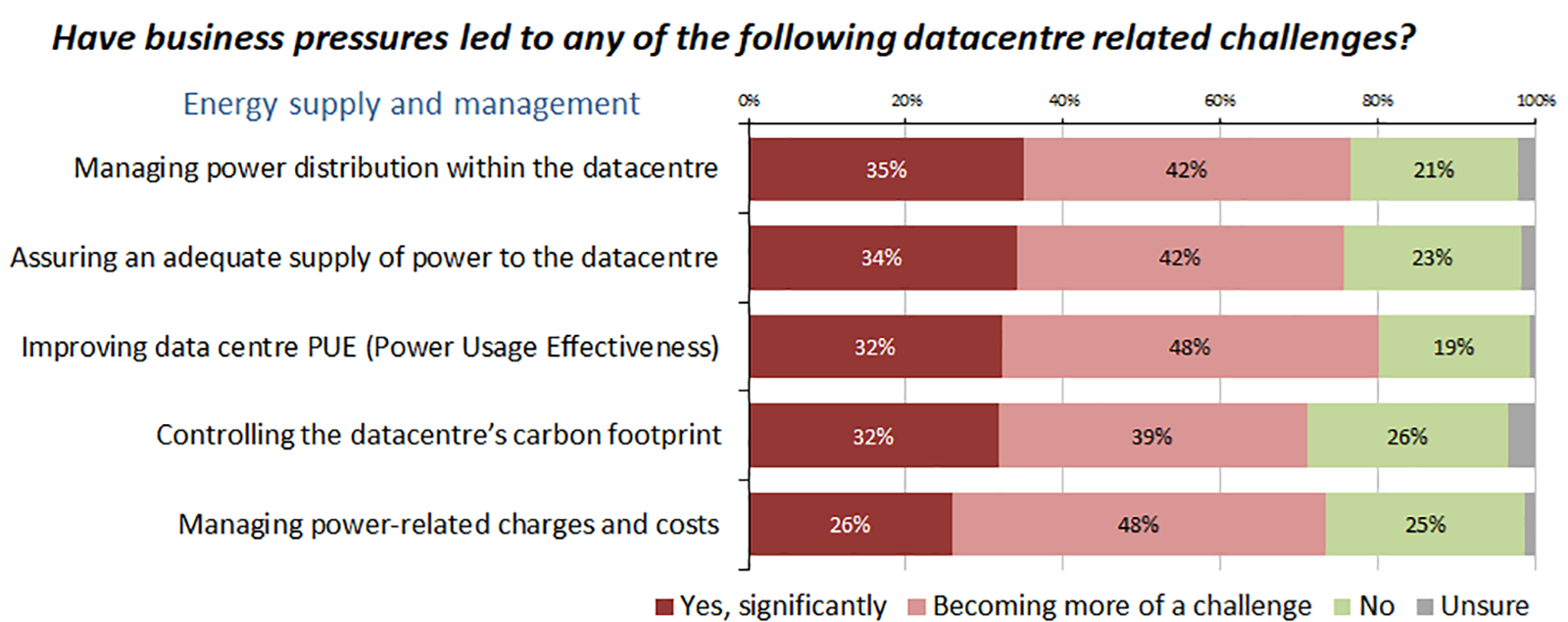 Coming back to the question of business continuity, power-related outages are clearly a very real issue for many.
Coming back to the question of business continuity, power-related outages are clearly a very real issue for many.
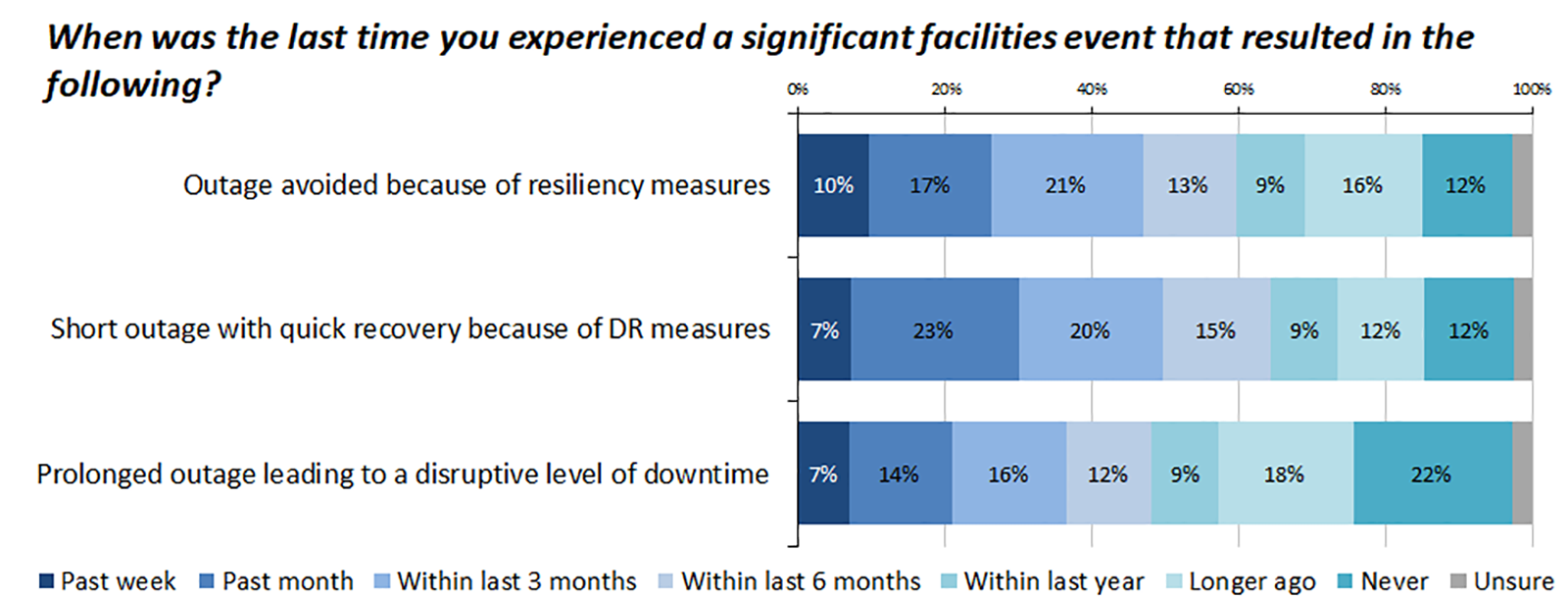 This picture goes hand-in-hand with the finding that only a minority of organisations are fully confident that they have sufficient power resilience and can respond quickly and effectively to power-related incidents and issues.
This picture goes hand-in-hand with the finding that only a minority of organisations are fully confident that they have sufficient power resilience and can respond quickly and effectively to power-related incidents and issues.
 The widespread occurrence of service outages, together with the lack of confidence in existing capabilities, is undoubtedly why many organisations say the datacentre facilities they currently have in place are in need of strengthening.
The widespread occurrence of service outages, together with the lack of confidence in existing capabilities, is undoubtedly why many organisations say the datacentre facilities they currently have in place are in need of strengthening.
 So, as demands for business service continuity escalate, are organisations taking active steps to improve matters? Working through the survey results we found that around a third overall have projects already underway to modernise datacentres generally, and the power infrastructure within this, with more telling us they are considering making such investments. But beyond these headline numbers, further investigation reveals something very interesting
During our analysis, we identified a group of respondents, some 30 percent of the survey base, who generally provide IT services more effectively than the rest of the research sample (see the ‘About the Research’ section for more details). The research showed that these ‘Top Performers’ are more likely to be investing or to be considering investments to modernise the power infrastructure in their datacentres compared to other organisations.
So, as demands for business service continuity escalate, are organisations taking active steps to improve matters? Working through the survey results we found that around a third overall have projects already underway to modernise datacentres generally, and the power infrastructure within this, with more telling us they are considering making such investments. But beyond these headline numbers, further investigation reveals something very interesting
During our analysis, we identified a group of respondents, some 30 percent of the survey base, who generally provide IT services more effectively than the rest of the research sample (see the ‘About the Research’ section for more details). The research showed that these ‘Top Performers’ are more likely to be investing or to be considering investments to modernise the power infrastructure in their datacentres compared to other organisations.
 While we always need to be careful about inferring cause and effect from correlations in surveys, the picture we see is consistent with the notion that continuous investment in datacentre facilities really is key to effective IT service delivery.
So what else can we learn from the Top Performer group?
Well, the survey highlights another important correlation, this time between the use of modern power management tools and the successful delivery of IT services.
While we always need to be careful about inferring cause and effect from correlations in surveys, the picture we see is consistent with the notion that continuous investment in datacentre facilities really is key to effective IT service delivery.
So what else can we learn from the Top Performer group?
Well, the survey highlights another important correlation, this time between the use of modern power management tools and the successful delivery of IT services.
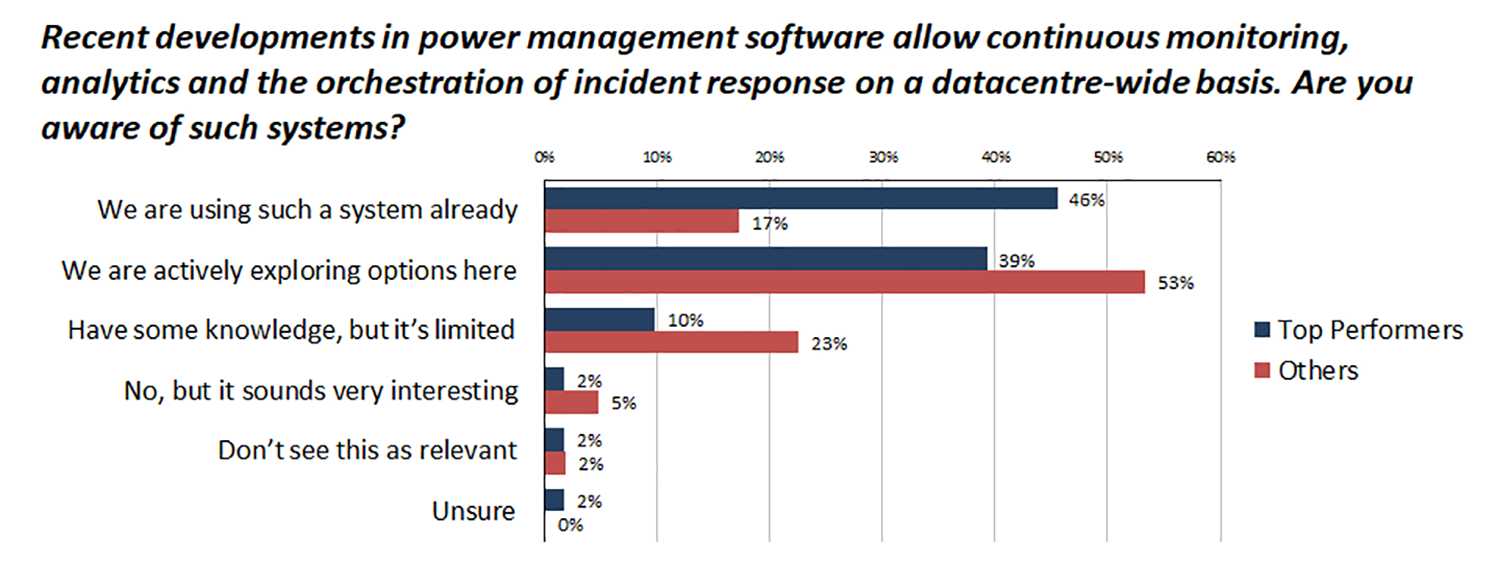 Advanced software has the potential to play an important role in improving power management within datacentres of all sizes, and a couple of key aspects of this are modelling and planning, followed by active and continuous monitoring. The propensity of Top Performers to exploit such tools undoubtedly plays a role in their ability to achieve more in both of these areas.
Advanced software has the potential to play an important role in improving power management within datacentres of all sizes, and a couple of key aspects of this are modelling and planning, followed by active and continuous monitoring. The propensity of Top Performers to exploit such tools undoubtedly plays a role in their ability to achieve more in both of these areas.
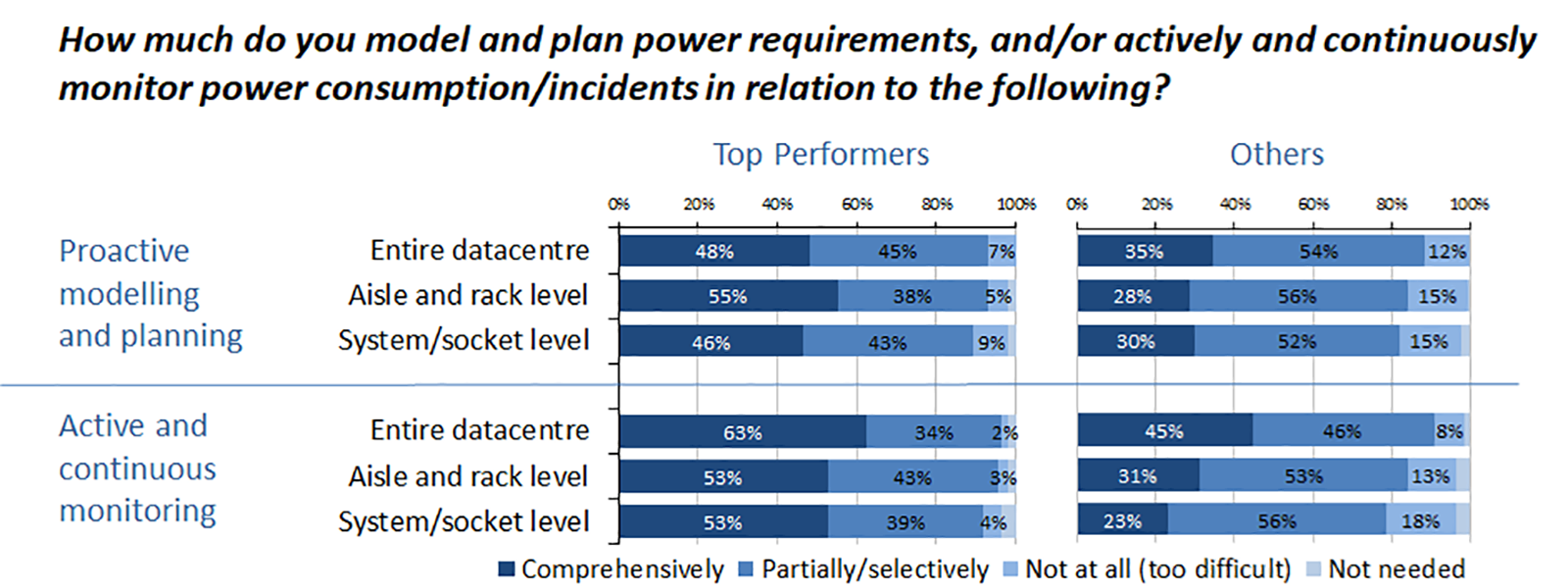 Based on these findings it seems reasonable to assume that the importance of advanced, sophisticated management tools will grow over time given some of the challenges and confidence gaps previously highlighted. But when it comes to key enablers, the confidence shortfall extends beyond tools and techniques, to the related question of skills and expertise.
Based on these findings it seems reasonable to assume that the importance of advanced, sophisticated management tools will grow over time given some of the challenges and confidence gaps previously highlighted. But when it comes to key enablers, the confidence shortfall extends beyond tools and techniques, to the related question of skills and expertise.
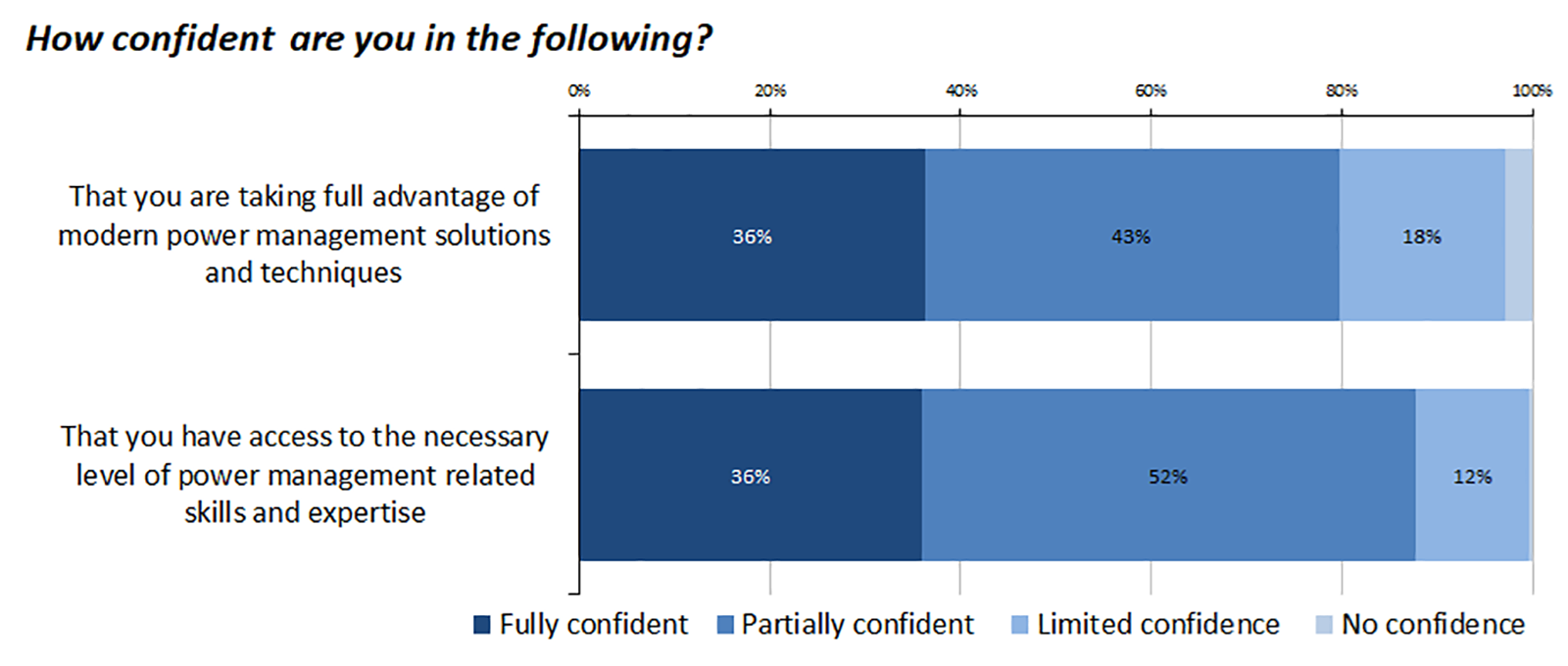 Pulling these two threads together, with systems infrastructure growing in complexity and skilled resources increasingly becoming difficult to obtain and expensive to use, software to automate power management represents a major opportunity to elevate service quality. It can also assist in keeping a hold on the costs of power usage, and improving the organisations posture in relation to corporate social responsibility (CSR), now actively on many executive agendas, even if it’s not yet a prime driver for change.
So how can we sum up the importance of the findings we have been discussing here?
Well, as business expectations continue to place greater pressure on IT systems to be available 24×7, service downtime is now a luxury few can afford. While the IT infrastructure generally gets a lot of attention here, it’s important not to forget the facilities part of the equation. Power resilience, for example, is now an absolute, and the complexity inherent in the architectures of modern datacentres makes automating this aspect of operations a key imperative. Indeed, investment in modern tooling and techniques in this area is arguably the only way overstretched staff will be able to maintain service quality and continuity.
The big question to ask yourself therefore, is whether the way you are approaching power management in your datacentre environment needs a rethink.
Pulling these two threads together, with systems infrastructure growing in complexity and skilled resources increasingly becoming difficult to obtain and expensive to use, software to automate power management represents a major opportunity to elevate service quality. It can also assist in keeping a hold on the costs of power usage, and improving the organisations posture in relation to corporate social responsibility (CSR), now actively on many executive agendas, even if it’s not yet a prime driver for change.
So how can we sum up the importance of the findings we have been discussing here?
Well, as business expectations continue to place greater pressure on IT systems to be available 24×7, service downtime is now a luxury few can afford. While the IT infrastructure generally gets a lot of attention here, it’s important not to forget the facilities part of the equation. Power resilience, for example, is now an absolute, and the complexity inherent in the architectures of modern datacentres makes automating this aspect of operations a key imperative. Indeed, investment in modern tooling and techniques in this area is arguably the only way overstretched staff will be able to maintain service quality and continuity.
The big question to ask yourself therefore, is whether the way you are approaching power management in your datacentre environment needs a rethink.

Tony is an IT operations guru. As an ex-IT manager with an insatiable thirst for knowledge, his extensive vendor briefing agenda makes him one of the most well informed analysts in the industry, particularly on the diversity of solutions and approaches available to tackle key operational requirements. If you are a vendor talking about a new offering, be very careful about describing it to Tony as ‘unique’, because if it isn’t, he’ll probably know.





Have You Read This?
From Barcode Scanning to Smart Data Capture
Beyond the Barcode: Smart Data Capture
The Evolving Role of Converged Infrastructure in Modern IT
Evaluating the Potential of Hyper-Converged Storage
Kubernetes as an enterprise multi-cloud enabler
A CX perspective on the Contact Centre
Automation of SAP Master Data Management
Tackling the software skills crunch